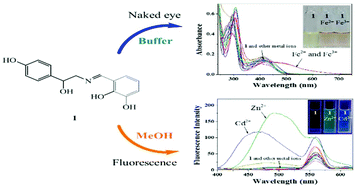当前位置:
X-MOL 学术
›
Photochem. Photobiol. Sci.
›
论文详情
Our official English website, www.x-mol.net, welcomes your
feedback! (Note: you will need to create a separate account there.)
Colorimetric detection of iron and fluorescence detection of zinc and cadmium by a chemosensor containing a bio-friendly octopamine†
Photochemical & Photobiological Sciences ( IF 2.7 ) Pub Date : 2018-03-05 00:00:00 , DOI: 10.1039/c7pp00468k Ji Hye Kang 1, 2, 3, 4 , Cheal Kim 1, 2, 3, 4
Photochemical & Photobiological Sciences ( IF 2.7 ) Pub Date : 2018-03-05 00:00:00 , DOI: 10.1039/c7pp00468k Ji Hye Kang 1, 2, 3, 4 , Cheal Kim 1, 2, 3, 4
Affiliation

|
Chemosensor 1 was synthesized by the reaction of octopamine with 2,3-dihydroxybenzaldehyde. Sensor 1 determined iron with an obvious color change from pale yellow to brown in nearly-pure water. The detection limits (0.55 and 0.25 μM) for Fe2+ and Fe3+, respectively, were far lower than the EPA (Environmental Protection Agency) guideline concentration for drinking water (5.37 μM). In addition, 1 could be employed to quantify iron in environmental water samples. Moreover, sensor 1 exhibited different fluorescence emissions in response to zinc (green) and cadmium (blue). The binding structures and sensing mechanisms of 1 for iron, zinc and cadmium were proposed from various spectroscopic studies and theoretical calculations.
中文翻译:

比色法检测铁,荧光法检测锌和镉,其中包含生物友好型章鱼胺的化学传感器†
化学传感器1是通过章鱼胺与2,3-二羟基苯甲醛的反应合成的。传感器1在几乎纯净的水中确定铁具有从浅黄色到棕色的明显颜色变化。Fe 2+和Fe 3+的检出限(0.55和0.25μM)远低于EPA(环境保护署)的饮用水标准浓度(5.37μM)。另外,可以采用1定量环境水样品中的铁。此外,传感器1响应于锌(绿色)和镉(蓝色)表现出不同的荧光发射。所述结合结构和感测机构1 各种光谱学研究和理论计算提出了用于铁,锌和镉的方法。
更新日期:2018-03-05
中文翻译:

比色法检测铁,荧光法检测锌和镉,其中包含生物友好型章鱼胺的化学传感器†
化学传感器1是通过章鱼胺与2,3-二羟基苯甲醛的反应合成的。传感器1在几乎纯净的水中确定铁具有从浅黄色到棕色的明显颜色变化。Fe 2+和Fe 3+的检出限(0.55和0.25μM)远低于EPA(环境保护署)的饮用水标准浓度(5.37μM)。另外,可以采用1定量环境水样品中的铁。此外,传感器1响应于锌(绿色)和镉(蓝色)表现出不同的荧光发射。所述结合结构和感测机构1 各种光谱学研究和理论计算提出了用于铁,锌和镉的方法。











































 京公网安备 11010802027423号
京公网安备 11010802027423号